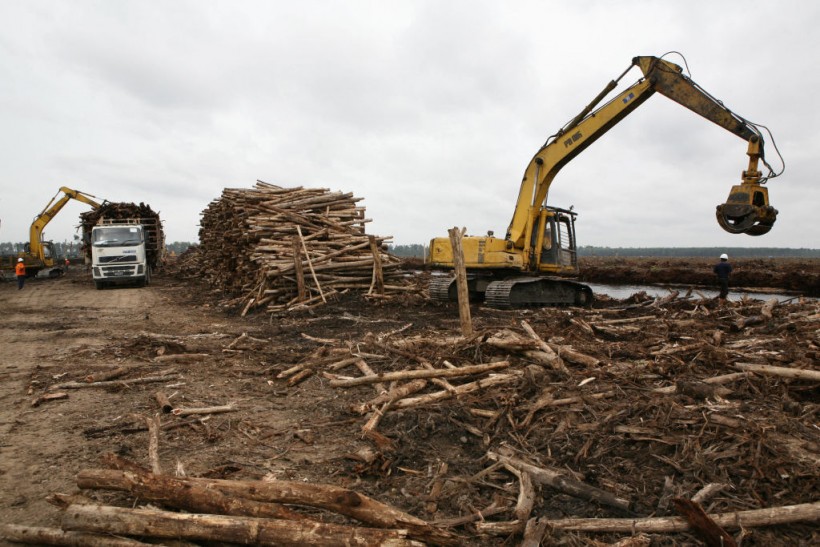Pulp mills produce a large amount of organic waste that is usually disposed of in landfills or incinerated.
However, a recent study suggests that applying this waste, known as biosolids, to soil can have multiple benefits for the environment and the industry.
Biosolids can mitigate soil greenhouse gas emissions from applied urea, a common fertilizer, and improve soil fertility in a hybrid poplar plantation, a fast-growing tree species that can be used for bioenergy production.
Biosolids Reduce Nitrous Oxide Emissions from Urea
 (Photo : AHMAD ZAMRONI/AFP via Getty Images)
(Photo : AHMAD ZAMRONI/AFP via Getty Images)

Urea is a synthetic fertilizer that contains nitrogen, an essential nutrient for plant growth.
However, when urea is applied to soil, it can stimulate the production of nitrous oxide (N2O), a potent greenhouse gas that contributes to global warming and ozone depletion.
N2O is mainly produced by soil microorganisms that use nitrogen as an energy source or as a by-product of their metabolism.
The study found that applying biosolids to soil before urea application can reduce N2O emissions by 40% compared to urea alone.
This is because biosolids can provide an alternative source of organic carbon for the microorganisms, reducing their dependence on nitrogen and thus their N2O production.
Biosolids can also increase the soil pH, which can inhibit the activity of some N2O-producing microbes.
Biosolids Enhance Soil Fertility and Poplar Growth
Biosolids are rich in organic matter and nutrients, such as phosphorus, potassium, calcium, and magnesium, that can improve soil quality and fertility.
The study showed that applying biosolids to soil increased the soil organic carbon, total nitrogen, and available phosphorus content, as well as the soil water-holding capacity and microbial biomass. These factors can enhance the soil's ability to support plant growth and productivity.
The study also measured the growth and yield of hybrid poplar trees, which were planted in the biosolids-amended soil and fertilized with urea.
The results showed that biosolids increased the poplar stem diameter, height, and biomass by 15%, 13%, and 18%, respectively, compared to the control treatment.
This indicates that biosolids can boost the performance of poplar plantations, which can provide a renewable source of biomass for bioenergy production.
Also Read: Asia Pulp and Paper's Innovations in Sustainable Forestry
Biosolids Offer a Win-Win Solution for the Environment and Industry
The study demonstrates that applying pulp mill biosolids to soil can be a win-win solution for the environment and industry.
Biosolids can help reduce greenhouse gas emissions from urea fertilizer, which can mitigate climate change and its impacts.
Biosolids can also improve soil fertility and poplar growth, which can increase the profitability and sustainability of bioenergy production.
Moreover, biosolids can divert waste from landfills or incineration, which can save costs and resources and reduce environmental pollution.
The study also suggests that the optimal rate of biosolids application is 10 Mg ha-1 (dry weight), which can achieve the maximum benefits without causing adverse effects on soil quality or plant health.
However, the study also acknowledged that the effects of biosolids may vary depending on the soil type, climate, and crop species and that further research is needed to optimize the biosolids management practices for different scenarios.
This not the only one that explores the potential of biosolids as a soil amendment.
Another study also found that biosolids can reduce soil greenhouse gas emissions and increase soil carbon sequestration in a wheat-maize rotation system.
These indicate that biosolids can be a valuable resource for enhancing soil health and crop productivity, as well as for mitigating greenhouse gas emissions from agriculture.
Related article: Paper Over Plastic: Sustainable Tourism With Asia Pulp and Paper
© 2024 NatureWorldNews.com All rights reserved. Do not reproduce without permission.

![Tsunami Hazard Zones: New US Map Shows Places at Risk of Flooding and Tsunamis Amid Rising Sea Levels [NOAA]](https://1471793142.rsc.cdn77.org/data/thumbs/full/70325/280/157/50/40/tsunami-hazard-zones-new-us-map-shows-places-at-risk-of-flooding-and-tsunamis-amid-rising-sea-levels-noaa.jpg)



